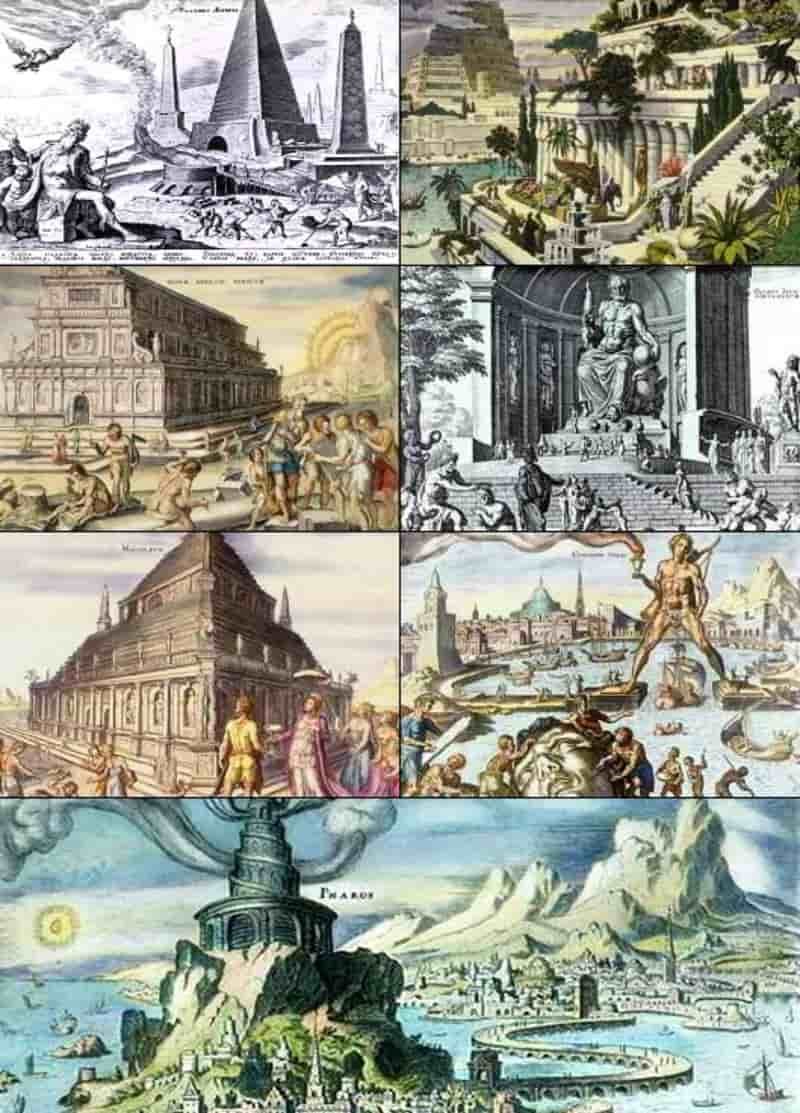7 Wonders of the Ancient World
The “7 Wonders of the Ancient World” include the Great Pyramid of Giza, Hanging Gardens of Babylon, Statue of Zeus at Olympia, Temple of Artemis at Ephesus, Mausoleum at Halicarnassus, Colossus of Rhodes, and Lighthouse of Alexandria.
The Seven Wonders of the Ancient World constitute the collection of seven architectural and artistic works considered to be the most extraordinary of the ancient world.
The origin of the list is unknown, but these works all correspond to achievements which greatly exceed the common proportions, showing that architects and builders of very ancient times were capable, by dint of labor and ingenuity, of works. exceptional monumental (in Greek: thaumasia).
The popularity of the monuments followed the political and economic influence of the cities, and the construction of an imposing architectural element saw this predominance enshrined (Memphis, Ephesus, Halicarnassus, Rhodes, Babylon, Olympia and Alexandria).
These seven works are: the pyramid of Cheops at Giza in Egypt, the Hanging Gardens of Babylon, the statue of Zeus at Olympia, the temple of Artemis at Ephesus, the mausoleum of Halicarnassus, the Colossus of Rhodes and the lighthouse of Alexandria.
7 Wonders of the Ancient World: Approximate date of construction, Location, Function, Owner, Builder, Disappearance
| 7 Wonders of the Ancient World | Approximate date of construction | Location | Function | Owner | Builder | Disappearance |
| Pyramid of Cheops | -2560 (+ 25 years of work) | Giza (Egypt) | Pharaoh’s tomb | Cheops | Hemiounou | Partial quarrying before the twentieth century. Still standing in the 21st century, but the facings have disappeared. |
| Hanging Gardens of Babylon | 6th century BC J.-C. | Babylon (Iraq) | Pleasure garden for a princess | Nebuchadnezzar II | Unknown | Disappeared from the third century BC. AD, with the decline and then the abandonment of the city. |
| Chryselephantine statue of Zeus | -436 (+ 4 years of work) | Olympia (Elis) | To sit in the new temple | The city of Olympia | Phidias | Transported to Constantinople in 420 or 422. Destroyed in a fire in 461. |
| Mausoleum of Halicarnassus | -353 (+ 3 years of work) | Halicarnassus (Decay) | Tomb of the royal couple | Mausole then Artémise II | Pytheus of Priene | Deteriorations from the 4th century (wars and bad weather). In the thirteenth century, a state of stagnation (earthquake?). Then quarrying for military defenses from the fourteenth century. |
| Temple of Artemis | -334 (+ several years of work) | Ephesus (Ionia) | Replacement of a destroyed temple (dedicated to Artemis) | The city of Ephesus | On the plans of the previous one (Théodore de Samos and Chersiphron) | Plundered in 263 by the Goths. Damaged by earthquakes. Partially relieved. Burned down in 401 by Christians. Then abandonment of the cult and exploitation in quarry in the fifth century. |
| Colossus of Rhodes | -292 (+ 12 years of work) | Rhodes (Greece) | In memory of the siege of the city raised by Demetrios I Poliorcète (-304) | Rhodes town | Chares of Lindos | Earthquake of -227 or -226 (broken at the knees, statue broken into several pieces). Then removal of debris in 654. |
| Lighthouse of Alexandria | -297 (+ 14 years of work) | Pharos Island in Alexandria (Egypt) | Navigation aid | Ptolemy I then Ptolemy II | Sostratus of Cnidus | Several times restored. Third floor destroyed by an earthquake in the tenth century. Damaged by a second earthquake in the 14th century. Gradually ruined; finally exploitation in quarry for military defenses from the fifteenth century. |
Photo credit: Wikimedia Commons



